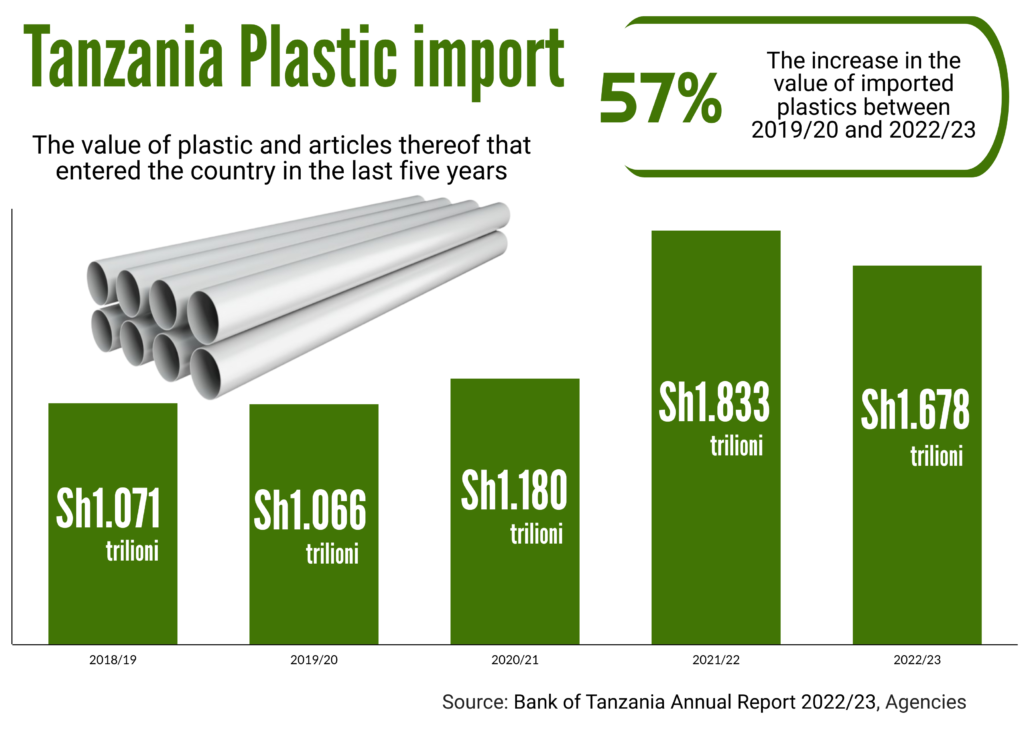Dar es Salaam. The surge in plastic usage parallels the expansion of the economy, according to insights from Professor Aurelia Kamuzora, a Senior Economist at Mzumbe University.
When queried about the escalating value of imported plastic in the country, she highlighted a significant increase reported by the Bank of Tanzania (BoT).
In the fiscal year 2022/23, the value of plastic and its products imported into the country reached Sh1.678 trillion—a noteworthy 57 percent surge compared to Sh1.066 trillion in 2019/20 and a substantial 72 percent increase from the Sh1.833 trillion recorded in 2021/22.
Despite global and national commitments to reduce plastic usage, the consumption of plastic continues to rise. Environmental concerns, including damage to marine and land ecosystems, threats to human and animal health, and contributions to climate change, have not been sufficient to curb this trend.
Professor Kamuzora underscores the rapid expansion of plastic innovations across various sectors, sparking discussions about alternative materials. She emphasizes that the world became cognizant of plastic’s adverse effects only after it had permeated multiple aspects of daily life, from clothing and utensils to the production of vehicles.
In the realm of economics, Dr Timoth Lyanga, an Economics Lecturer at the Open University of Tanzania (OUT), highlights that the surge in plastic imports is indicative of the material’s pivotal role in propelling industrial sectors, particularly construction.
Notably, industries, especially those involved in manufacturing construction materials, heavily rely on plastic raw materials, contributing significantly to the growth of various sectors.
On the other hand, Baraka Machumu, a climate change activist, draws attention to the absence of effective bans or regulations on plastic use in neighboring countries like Burundi, Rwanda, and the Congo.
The lack of uniformity in policies poses challenges and emphasizes the crucial need for collaborative efforts to enforce bans, benefiting all countries involved.

Plastic Bans and Regulations in Tanzania
Environmental Management (Prohibition of Plastic Carrier Bags and Plastic Bottle Cap Seals) regulations of 2022 emphasized the types and uses of plastic allowed, amends the 2019 regulations.
According to section five to seven of these regulations, ” All plastic carrier bags, regardless of their thickness are prohibited from being imported, exported, manufactured, sold, stored, supplied and used in Mainland Tanzania”.
“A person shall not import, export, manufacture, store, distribute, supply, sell or offer for sale beverages with plastic bottle cap seals. A person shall not sell or offer for sale beverages or commodities wrapped in plastic unless the nature of such commodities requires wrappings by plastics”.
Senior Officer from the National Environmental Management Council (NEMC), Arnold Mapinduzi, clarified that the law permits the use of plastic packaging for products requiring such protection, intending to prevent damage before reaching consumers.
Mapinduzi, stated that the law does not permit the use or sale of any plastic bags, whether with handles or without, for products that do not necessarily require packaging.
“What is allowed is plastic packaging for products that require protection in packaging made from plastic raw materials. The goal is to prevent these products from deteriorating before reaching the consumer or before their intended shelf life. This is to safeguard the quality of the products,” he emphasized.
Mapinduzi clarified that the purpose of packaging is to ensure that the product reaches the market, not to package it at the market or in other trading areas.
“… if done at the market or other areas, that is carrying, and it is illegal; the law prohibits it,” he said. “Also, the packaging must indicate who produced or packaged the product, so that in case of issues, we can identify who to approach for resolutions and ensure people get their rights,” Mapinduzi explained.
He stressed the importance of displaying the capacity to carry and specifying when the usage ends. “However, using it as a carrier for items like meat, carrots, or vegetables at the market is not acceptable, and the law states that changing the packaging into a carrier is an offense.”
The official mentioned that environmental committees and environmental officers have a significant responsibility in overseeing these matters according to the law, and the leaders of these committees are the directors of the local authorities. These individuals are required to work together, and if assistance is needed, NEMC is available.
Alternatives and Solutions to Plastic
Professor Kamuzora acknowledged the extensive use of plastic and highlighted the difficulty in finding suitable alternatives. She suggested investing in research and developing technologies that can replace plastic in various products.
Professor Kamuzora proposed exploring alternatives such as hemp, which can be used for making clothing, ropes, and bags, provided the country is ready to embrace such technologies.
She stressed the importance of government-led research and development, recommending that technical and vocational training institutions be involved in teaching relevant skills. Professor Kamuzora drew parallels with countries like China, which have successfully developed technologies based on traditional knowledge.
Director of the Institute of Humanity and Environmental Development (HUDEFO), Sarah Pima, expressed optimism that improvements in environmental laws would help control plastic production. She emphasized the importance of holding plastic producers accountable for recycling, as instructed by NEMC, with deadlines set for March 2024.

Hazards of Plastic on Biodiversity, Health, and Economy
The 2004 Environmental Management Act, Section Six, states that “Any person living in Tanzania shall be a stakeholder and is obligated to preserve and sustain the environment, reporting to the relevant authorities about any activity or matter that significantly affects the environment.”
A 2017 study titled “Production, Usage, and Fate of All Ever-Made Plastics” by American scholars revealed that plastic production and disposal contribute to climate change through the emission of greenhouse gases, stemming from fossil fuel.
NEMC Officer Mapunduzi mentioned that research indicates 8 to 10 million tons of plastic enter the oceans annually, projecting that by 2050, there will be more plastic than fish in the waters. There are cases of fish dying due to ingestion or suffocation caused by plastic, posing a threat to vital economic sectors relied upon by many.
Not only the importation but also the production of plastic-based products has increased, such as chairs that were not prevalent in the past. This presents a challenge, and effective management is not easy.
Mapinduzi explained that there are no issues with products that can be easily recycled, but the real problem lies with those spreading in the streets, clogging drains; the main culprit being plastic. Apart from the infrastructure issues, the health implications are severe, as any plastic entering the bodies of humans or animals is non-digestible.
Cases have been documented of animals ingesting plastic, resulting in fatalities. Even if ingested by humans, plastic does not break down and can be inherited, affecting various bodily systems. Microplastic particles have been found in breast milk and human urine from eight years old and above.
The toxic chemicals adhering to plastic contribute to air pollution upon entering the body, leading to health issues, including cancer, and affecting the reproductive system. The aim is to avoid having a nation with a weakened workforce or one burdened with numerous diseases, diverting budgets from other sectors to healthcare.
According to the Ministry of Health, the Ocean Road Cancer Institute forgave Sh37.29 billion Tanzanian Shillings for some treated patients in 2022/23 and Sh13.9 billion in 2021/22. The institute treated a total of 43,922 patients, compared to 37,882 in that period. These diseases are also treated in regional and district hospitals.



Your article helped me a lot, is there any more related content? Thanks!